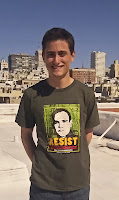 Moshe Baran is a Polish-Jewish partisan who escaped from a labor camp near Krasne and joined a Russian partisan group. Now in his 90s, Moshe Baran lives in Pittsburgh, and devotes his time to speaking out about his experiences and the destructive power of hatred, which can have devastating consequences for society if left unchecked.
Moshe Baran is a Polish-Jewish partisan who escaped from a labor camp near Krasne and joined a Russian partisan group. Now in his 90s, Moshe Baran lives in Pittsburgh, and devotes his time to speaking out about his experiences and the destructive power of hatred, which can have devastating consequences for society if left unchecked.
Moshe maintains an active blog entitled Languages Can Kill: Messages of Genocide, which focuses on hate speech and its consequences. We are proud to repost his reflections on the United States Holocaust Memorial Museum's 20th anniversary celebration, which he attended this spring:
Memories Revisited
It is Monday, April 28, 2013 in Washington, DC, and we are approaching May 8, the 68th anniversary of the end of the war. The Holocaust Museum is celebrating the 20th anniversary of its opening. I am attending a salute to the veterans of WWII and Holocaust survivors, a gathering of more than 4000 people, among them 900 survivors and 150 veterans. We are assembled to witness the presentation of the flags of the American divisions who entered concentration camps in Germany and Austria. The Army orchestra plays as each unit enters with its flag and a voice announces the camps they liberated. Those who are present rise and applaud, my face and those around me flooding with tears of sorrow and pain mixed with tears of joy and pride in those who finally destroyed the beast of the 20th century. President Clinton, Elie Wiesel, teachers and students who are engaged in preserving the memory of the Holocaust are sharing their experiences.
As I stand there, my memory takes me back to January of 1945 when the Second Russian Army, of which I was part, moved west to seal the fate of Hitler’s thousand year Reich. We drove over recent battlefields where the remnants of vehicles were mixed with the remains of bodies. It takes me back to the summer of 1944 when the Russian army, after several years of fighting German hordes, advanced to the west and liberated Belarus and entered Poland. I was part of the resistance that was sabotaging the communications of the occupying forces. I remember the day in 1942 when I stole weapons from a German warehouse, escaped from the forced labor camp where I had been imprisoned for six months, found a group of local Jews who had sought shelter in the surrounding forests and swamps and joined the resistance. I recall the horrible time in the fall of 1941 when the Germans ordered us out of our ancestral homes and herded 300 families into 15 homes, separated by barbed wire from the rest of the town and guarded around the clock, deprived of access to food, water and basic necessities. There we waited knowing that we are doomed, trembling at the sound of mechanized vehicles that might signal the arrival of our fate. From behind the barbed wire we watched as our former neighbors went about their lives assembling in the church across the street to pray after they had been preying on us, performing weddings accompanied by the sound of music. My mind goes back to the good old days prior to 1939 when under Polish rule, in the midst of a Belarusian minority, we enjoyed a naively tranquil life in the shtetl, a village of 300 families, a rabbi, a Hebrew day school, a bank, a free loan association, and volunteers who cared for widows, orphans, and those just passing through. That all came to an end when the Red Storm from the east and the Nazi hell that eventually engulfed all of Europe from the west converged in our place.
I move back towards the present, recalling a visit to an extermination camp in Poland in 2004 accompanied by my son-in-law Paul and grandsons Yossi and Boaz. After stepping out of the barracks where we saw compartments with childrens’ shoes, clothing, and luggage marked from various countries, Paul went outside, sat on the steps and burst into tears. He cried and cried, lacking words, and expressing in the only way he could the despair that he felt.
What is the responsibility of those of us who survived, and those who witnessed the liberation of the concentration camps? It is to share our memories with as wide an audience as possible. We are the last of those who can tell the story in the first person, who can bear personal witness to the destruction of an entire culture. It is painful for us to reach the point in life where the world is so unsettled, where killings and bombings are a daily occurrence. We hoped that WWII would be the end of all wars, but today we live in a world where the institutions of peace are paralyzed and where war is an everyday event, an unremarkable item in the news over which we shake our heads.
In the great economic turmoil of the last few years, there is one bright spot. Israel, the bright and beautiful child of the tragedy of WWII, the dream of a people who were nearly destroyed, has emerged unscathed, one of only five countries that continued to grow and prosper during the worst economic downturn since the Great Depression. We pray and hope that the example set by Israel will serve as a beacon to humankind.













 Can be used in as little as 30 minutes
Can be used in as little as 30 minutes Ethics of War
Ethics of War

















